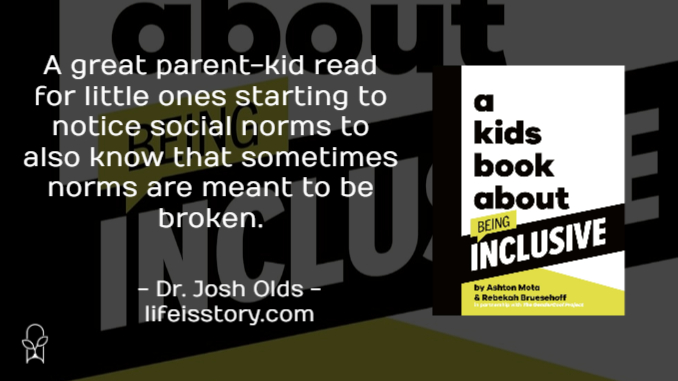
Series: A Kids Book
Published by DK Books on April 4, 2024
Genres: Children's, Children's Educational
Buy on Amazon
Goodreads

A clear explanation of what inclusivity is, and what it means to be inclusive.
This is a kids book about being inclusive. Being inclusive is a choice we can make every day!
What does it mean to be inclusive? It means reaching out to and welcoming all people and everything that makes them who they are. This book is an introduction to inclusivity, and helps to start discussions about the topic with kids aged 5-9. When we learn to see the beauty in our differences, we can embrace the rich, diverse, and amazing world we live in together!
A Kids Book About Inclusivity features:
- A large and bold, yet minimalist font design that allows kids freedom to imagine themselves in the words on the pages.
- A friendly, approachable, yet empowering, kid-appropriate tone throughout.
- An incredible and diverse group of authors in the series who are experts or have first-hand experience of the topic.Tackling important discourse together!
The A Kids Book About series are best used when read together. Helping to kickstart challenging, empowering, and important conversations for kids and their grownups through beautiful and thought-provoking pages. The series supports an incredible and diverse group of authors, who are either experts in their field, or have first-hand experience on the topic.
Jamie Bruesehoff’s Raising Kids Beyond the Binary may very well end being one of my favorite books of 2024, so when I found out that DK Books was issuing a new edition of her daughter Rebekah’s book, I knew I definitely wanted to read it. A Kid’s Book About Being Inclusive is written as a conversation between the two authors—Ashton Mota and Rebekah Bruesehoff—both transgender teens. The book is part of a series that highlights various difficult topics and explains them in language appropriate for elementary age students. There are books on equality, disability, body image, gender, and more. This specific book is written in association with the GenderCool Project, a youth-led organization of genderqueer kids dedicated to education and activism.
A Kid’s Book About Being Inclusive is written with simplicity and clarity. It often like the book was a transcription of a conversation. Rebekah and Ashton begin by introducing themselves and explaining how they met through The GenderCool Project. They set the definition of inclusion as “kind of like sharing…but bigger.” They explain that being inclusive means celebrating everyone for being their unique selves.
Both kids then talk about their experience of being transgender and how their family loved and supported them as they determined what that meant for them. They are clear that being transgender isn’t a choice, but part of who they are.
The latter half of the book talks about ways in which readers can be inclusive—and it’s not just talking about gender identity. Inclusivity, rather, is about inviting anyone in who, for any reason, has been out: skin color, religion, gender, dress, disability, the language they speak, and more. Ashton and Rebekah invite readers to go out of their way to include people not normally in their groups into their groups. You have to ask “Who is being left out?” and make sure that person is not being left out.
Even though this book is written by two transgender teens, A Kid’s Book About Being Inclusive isn’t exclusively about gender inclusivity. Other than mentioning it as part of their own story, Ashton and Rebekah treat gender inclusivity as only part of a subset of a larger whole. I appreciated this because it makes gender inclusivity relatable and accessible to young kids, removing it from the “cultural hot topic” status and placing it in with being inclusive of people new to one’s school. However, if you are looking for a book that addresses being transgender, Gia Parr’s A Kid’s Book About Being Transgender is the one you’re looking for.
I do wish—and this seems to be the design of the overall series—that there had been some illustrations or something else eye-catching for younger kids. Just having that visual example acting out what is being said in the book goes a long way, I think, for even older elementary kids to grasp the message in multiple ways. Regardless of that, A Kid’s Book About Being Inclusive is a great parent-kid read for little ones who are beginning to develop an understanding of social norms and that sometimes norms need to be broken.
